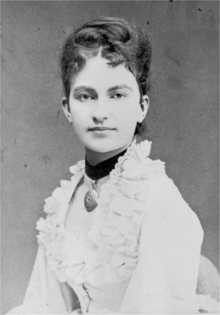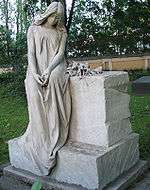Anna Yesipova
Anna Yesipova (born Anna Nikolayevna Yesipova [Russian: Анна Николаевна Есипова] in Saint Petersburg, 12 February [O.S. 31 January] 1851 — died 18 August [O.S. 5 August] 1914, Saint Petersburg) was a prominent Russian pianist. Her name is cited variously as Anna Esipova; Anna or Annette Essipova; Anna, Annette or Annetta Essipoff; Annette von Essipow; Anna Jessipowa.
Anna Yesipova | |
|---|---|
 | |
| Background information | |
| Born | February 12, 1851 Saint Petersburg, Russia |
| Died | August 18, 1914 (aged 63) Saint Petersburg |
| Occupation(s) | Musician, professor |
| Instruments | Piano |
| Years active | 1871–1914 |
Life

Yesipova was one of Teodor Leszetycki's most brilliant pupils. She made her debut in Saint Petersburg in 1871 attracting rave reviews and the artistic admiration of both Pyotr Ilyich Tchaikovsky and Franz Liszt, particularly for her effortless virtuosity and singing tone. She then began concert tours which brought her in 1876 to the United States, where her playing was greatly admired. She heard the playing of Fanny Bloomfield and advised her to train under Leszetycki, whom Yesipova married in 1880 and later divorced. In the Summer of the same year she gave a number of concerts in Lisbon, where she had a very warm reception.[1]
In 1885, Yesipova was appointed Royal Prussian Court Pianist. From 1893 to 1908, she was professor of pianoforte at the Saint Petersburg Conservatory. Among her students were Sergei Prokofiev, Leff Pouishnoff, Sergei Tarnowsky, Maria Yudina, Leonid Kreutzer, Isabelle Vengerova, Anastasia Virsaladze, Leo Ornstein, Isidor Achron, Thomas de Hartmann, and Alexander Borovsky (Borowsky) [1889–1968]. See: List of music students by teacher: T to Z#Anna Yesipova.
Recordings
In the early 1900s, Yesipova made a number of piano rolls, some of which have made been available as modern recordings (including Thalberg's Fantasia on a theme from Bellini's La Sonnambula).[2] Anna Essipova (Welte-Mignon Piano Rolls) - Pupils of Leschetizky Vol.1
There is one extant acoustic recording of her playing, which is Benjamin_Godard's Gavotte in G, made onto an Edison cylinder by Julius Block in 1898.
Notes
- Cf. e.g. Diario Ilustrado of July 15th, 1880.
- Through the Night program on BBC Radio 3, 28 February 2010
References
- This article incorporates text from a publication now in the public domain: Gilman, D. C.; Peck, H. T.; Colby, F. M., eds. (1905). New International Encyclopedia (1st ed.). New York: Dodd, Mead. Missing or empty
|title=(help) - Comtesse Angèle Potocka: Theodore Leschetizky, an intimate study of the man and the musician. New York, The Century co., 1903 p. 223 f.